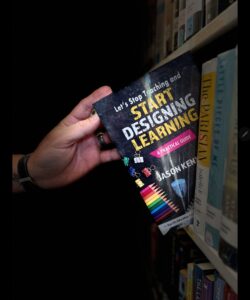Imagine a captain steering a ship without understanding the wind, tides, or the stars to guide them. They might keep the ship afloat and the crew busy, but they wouldn’t navigate it to the desired destination. The ship is simply drifting in whatever currents it wanders into.
Without a solid understanding of what learning is and how it happens, leaders may manage schools efficiently but fail to lead them toward true educational success. Understanding learning is indispensable for educational leaders, and it defines the distinction between managing and leading. Here are some information and practical steps leaders can take to enhance their instructional leadership.
The Nature of Leadership in Education: Beyond Content Expertise
Too often, leaders shy away from instructional leadership because they feel unprepared to engage with the diverse array of subjects taught in their schools. They might worry that they lack deep content expertise in areas like advanced mathematics, foreign languages, or emerging technologies. However, this reluctance misses a crucial truth: learning is a universal process. Regardless of content, the principles of learning remain the same, rooted in evidence-based strategies that focus on how people acquire, process, and apply knowledge. Leaders do not need to be experts in every subject, but they must be experts in learning itself—able to identify and support instructional practices that create meaningful, measurable, and lasting impacts.
Leadership in education requires shifting the focus from content delivery to fostering environments where learners are actively engaged in their growth. This means recognizing that effective learning transcends subjects and is driven by clear goals, purposeful instruction, and consistent feedback. Without this understanding, leaders risk reducing their role to mere management, addressing logistical challenges but neglecting the school’s true mission: cultivating learners who are critical thinkers, problem solvers, and collaborators.
Managing Systems, Leading Learning
Management involves maintaining systems and ensuring the smooth operation of a school. It’s about logistics—managing resources, overseeing schedules, and resolving conflicts. These tasks are undeniably important; they form the backbone of a school’s daily functioning and ensure that the gears of the institution turn smoothly. However, management is inherently reactive, focused on maintaining the status quo and addressing immediate needs. Leadership, in contrast, is proactive, requiring vision and the ability to influence others toward achieving the core mission of schools: fostering learning.
True leadership goes beyond balancing budgets and coordinating bus schedules. It requires an intentional focus on inspiring a shared purpose and guiding a community toward meaningful improvement. Leaders are tasked with shaping a culture where learners thrive, where teachers feel supported, and where innovation and collaboration are celebrated. They must engage in the difficult but rewarding work of aligning all efforts—be it professional development, instructional strategies, or school policies—with the ultimate goal of improving learning outcomes. Leadership asks, “What more can we do to ensure that every learner achieves their potential?” while management often asks, “How can we make this process smoother?” Both are needed, but leadership is what drives transformation and lasting change.
The Challenge of Transformational Leadership
Transformational leaders understand that their role is to create a culture where learning is the centerpiece. This requires both inspiring others and having a deep enough understanding of instructional practices to ensure that inspiration translates into action. Such leaders know that a vision without execution is merely a dream, and they bridge the gap by embedding evidence-based practices into the fabric of their schools. They focus on creating environments where teachers feel empowered to innovate, collaborate, and reflect on their practices, and where learners are engaged in meaningful, purposeful activities that promote critical thinking and growth.
To build this culture, transformational leaders must prioritize professional learning and model lifelong learning themselves. They stay informed about the latest research on effective instruction and actively participate in discussions about pedagogy. By doing so, they can guide teachers not just with motivational rhetoric but with practical, actionable strategies tailored to their unique school contexts. These leaders also ensure that systems of accountability and support are in place, such as regular feedback cycles, collaborative planning opportunities, and access to resources that enable continuous improvement. Transformational leadership is not about occasional bursts of inspiration; it’s about sustaining a long-term commitment to fostering a community where learning is valued, visible, and achievable for all.
Three Steps Toward Instructional Leadership
1. Redefine Your Role
Educational leaders must embrace their role as leaders of learning rather than just managers of operations. Start by asking yourself daily: “What did I do today to promote learner learning?” If the answer is unclear, reevaluate your priorities.
Keep a daily journal or digital tracker to answer these two questions:
- What did I do to promote learning today?
- What did I do to support teachers today?
This habit builds accountability and keeps your focus aligned with the mission of fostering learning.
2. Learn the Science of Learning
The shift from teaching to learning requires leaders to understand evidence-based practices. Designing learning targets and ensuring clarity can have a profound impact on learner outcomes. Leaders who understand key strategies like scaffolding, feedback, and collaborative learning can better support their teachers.
Create opportunities for collaborative professional development where teachers can experiment with and refine instructional strategies. For example, focus one session on feedback, where teachers analyze sample learner work and practice providing actionable, growth-oriented feedback. Follow up with classroom observations to see these strategies in action.
3. Foster a Culture of Collaboration
Great leaders empower teachers to share strategies and reflect on their practice. Professional Learning Communities (PLCs) are a proven way to promote this culture, offering structured opportunities for teachers to align their work with evidence-based practices.
In every PLC meeting, ensure that discussions are anchored in:
- A clear focus on learner learning outcomes.
- Analysis of learner work and assessment data.
- Actionable next steps for teachers to refine their practice.
Provide teachers with protocols like the “Looking at Learner Work” protocol or the “Five Whys” analysis tool to deepen conversations and keep the focus on learning.
A leader who knows the currents of learning can guide their school with purpose. They can chart a course, adjust the sails, and empower their crew to navigate challenges. Without this knowledge, leaders may keep the ship afloat, but they’ll struggle to steer it toward its destination.
True leadership in education demands more than management—it requires a commitment to understanding and prioritizing learning. By engaging in reflective practices, learning the science behind instruction, and fostering collaboration, leaders can transform schools from places of compliance to vibrant centers of growth, ensuring every learner and teacher thrives.


